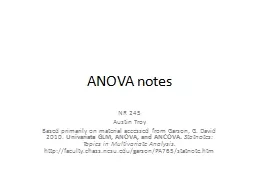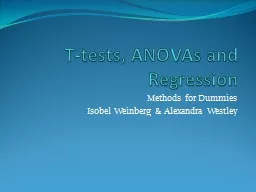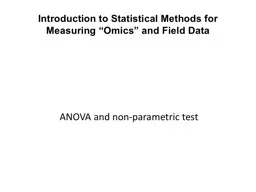PPT-Two-Way Balanced Independent Samples ANOVA
Author : cheryl-pisano | Published Date : 2017-01-22
Computations Contrasts Confidence Intervals Partitioning the SS total The total SS is divided into two sources Cells or Model SS Error SS The model is Partitioning
Presentation Embed Code
Download Presentation
Download Presentation The PPT/PDF document "Two-Way Balanced Independent Samples ANO..." is the property of its rightful owner. Permission is granted to download and print the materials on this website for personal, non-commercial use only, and to display it on your personal computer provided you do not modify the materials and that you retain all copyright notices contained in the materials. By downloading content from our website, you accept the terms of this agreement.
Two-Way Balanced Independent Samples ANOVA: Transcript
Computations Contrasts Confidence Intervals Partitioning the SS total The total SS is divided into two sources Cells or Model SS Error SS The model is Partitioning the SS cells. Methods for Dummies. Isobel Weinberg & Alexandra . Westley. Student’s t-test. Are these two data sets significantly different from one another? . William Sealy Gossett. Are these two distributions different?. Analysis by SAS. Interaction Plot . by Excel. The Design. Type of Crime: Burglary or Swindle. Culture of Defendant: American or Chinese. Sex of Juror: Female or Male. DV: Recommended length of sentence. AMS 572 Group 5. Outline. Jia. Chen: Introduction of repeated measures ANOVA. Chewei. Lu: One-way repeated measures . Wei Xi: Two-factor repeated measures. Tomoaki. Sakamoto : Three-factor repeated measures. NR 245. Austin Troy. Based primarily on material accessed from Garson, G. David 2010. . Univariate GLM, ANOVA, and ANCOVA. . Statnotes. : Topics in Multivariate Analysis.. http://faculty.chass.ncsu.edu/garson/PA765/statnote.htm. The . Univariate. Approach. An ANOVA Factor Can Be. Independent Samples. Between Subjects. Correlated Samples. Within Subjects, Repeated Measures. Randomized Blocks, Split Plot. Matched Pairs if . k. Methods for Dummies. Isobel Weinberg & Alexandra . Westley. Student’s t-test. Are these two data sets significantly different from one another? . William Sealy Gossett. Are these two distributions different?. . Chapter 10 - Analysis of Variance (ANOVA). . Introduction. 10.1 - Single-Factor ANOVA. 10.2 - Multiple Comparisons in ANOVA. 10.3 - More on Single-Factor ANOVA. Group. Samples. Group Means. ANOVA. Multiple Comparisons. Pairwise Comparisons and . Familywise. Error. . . fw. is the . alpha familywise. , the conditional probability of making one or more Type I errors in a family of . Research Methods in Physical Activity. Research Methods in Physical Activity. Purpose and Protocol of the Statistical Test. The purpose of the statistical test is to evaluate the null hypothesis at a specific level of probability (e.g., p < .05). In other words, do the two levels of treatment differ significantly (p < .05) so that these differences are not attributable to a chance occurrence more than 5 times in 100?. Marshall University Genomics Core Facility. Two-Way ANOVA. In one-way ANOVA, we measured a continuous variable in three or more different categorical groups. We think of this as one dependent variable (the continuous “outcome” variable) and one independent variable (the group). Data . Set. Popcorn Oil amt. Batch Yield. plain . little. large 8.2. gourmet little large 8.6. plain . . lots large 10.4. gourmet lots large 9.2. ANOVA. . and non-parametric test. Overview. Measure of central tendency (summary statistics). Measure of variability . Hypothesis testing. ANOVA. Why study statistics. Need to understand and use data to make decisions.. Two-way ANOVA Factor Level Means Study Cells defined b y combinations of t w o or more discrete f actors All o ws ef f ects to be decomposed into main ef f ects and inte r actions Model assumptions remain unchanged ANOVA is comparison of means. Each possible value of a factor or combination of factor is a treatment.. The ANOVA is a powerful and common statistical procedure in the social sciences. It can handle a variety of situations..
Download Document
Here is the link to download the presentation.
"Two-Way Balanced Independent Samples ANOVA"The content belongs to its owner. You may download and print it for personal use, without modification, and keep all copyright notices. By downloading, you agree to these terms.
Related Documents














